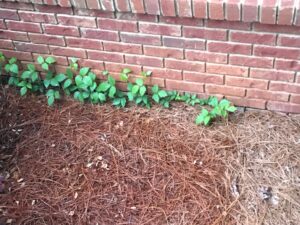Poison Ivy skin allergen
Poison Ivy and urushiols
This post is about Poison Ivy skin allergen. Poison ivy rash is caused by an allergic reaction to an oily resin called urushiol. This oil is in the leaves, stems and roots of poison ivy, poison oak and poison sumac. Consequently, urushiol, an oily mixture of organic compounds with allergenic properties found in plants of the family Anacardiaceae, especially Toxicodendron spp. (e.g., poison oak, Chinese lacquer tree, poison ivy, poison sumac), Comocladia spp. (maidenplums), Metopium spp. (poisonwood), and also in parts of the mango tree as well as the fruit of the cashew tree
If you come in contact with these plants

Poison Ivy along a foundation caused a skin allergen reaction
Wash your skin right away if you come into contact with this oil. Obviously, this is prudent unless you know you’re not sensitive to it. Washing off the oil may reduce your chances of getting a poison ivy rash. If you develop a rash, it can be very itchy and last for weeks.
About Urushiol
Urushiol in its pure form is a pale-yellow liquid with a density of about 0.968 g/mL and a boiling point of 200 °C (392 °F). It is soluble in diethyl ether, acetone, ethanol, carbon tetrachloride, and benzene.
Urushiol is a mixture of several closely related organic compounds. Each consists of a catechol substituted in the 3 position with a hydrocarbon chain that has 15 or 17 carbon atoms. The hydrocarbon group may be saturated or unsaturated. The exact composition of the mixture varies, depending on the plant source. Whereas western poison oak urushiol contains chiefly catechols with C17 side-chains, poison ivy and poison sumac contain mostly catechols with C15 sidechains.
In summary, the likelihood and severity of allergic reaction to urushiol is dependent on the degree of unsaturation of the hydrocarbon chain. Less than half of the general population experience a reaction with the saturated urushiol alone, but over 90% do so with urushiol that contains at least two degrees of unsaturation (double bonds). Longer side chains tend to produce a stronger reaction.